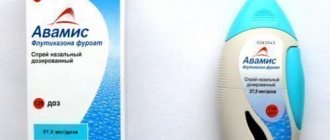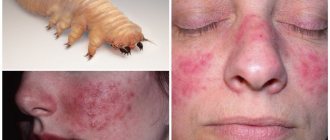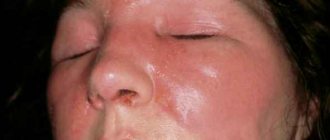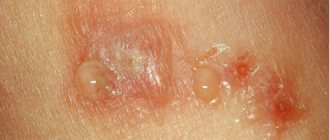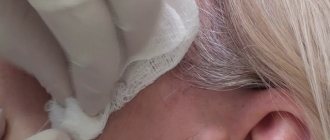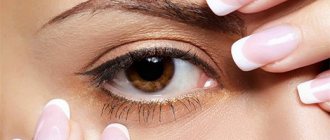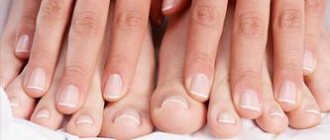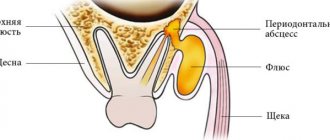Causes of vitiligo
Vitiligo is a chronic disease in which depigmented patches appear on the skin and tend to get larger.
Usually the sudden onset is followed by slow growth of the spots or a period of stabilization. People suffer from vitiligo at any age, but in 50% of cases the disease begins between 10 and 30 years of age, and is extremely rare among older people. Men and women get sick equally often. Vitiligo is a disease with a hereditary predisposition. More than 30% of patients have a family history. Risk factors are:
- stress and nervous system disorders,
- skin injuries,
- intoxication, contact with harmful chemicals,
- gluten intolerance,
- chronic inflammatory diseases,
- autoimmune diseases,
- gastrointestinal diseases,
- liver diseases,
- endocrinopathies,
- diabetes,
- decreased immunity,
- sunburn.
There are three theories about the development of vitiligo:
- theory of self-destruction of melanocytes - implies the formation in the process of melanin biosynthesis of substances toxic to melanocytes;
- neurogenic theory - based on the fact of interaction of melanocytes with nerve cells;
- autoimmune theory - talks about the destruction of melanocytes by activated cytotoxic T lymphocytes.
The role of genetic factors, humoral immunity and cytokines is not fully understood.
Manifestations of vitiligo on the skin are based on the following classification:
- pink - before the appearance of white spots, erythema (redness) develops, which is already accompanied by itching and then peeling;
- mesh - white spots on the skin contain pigmented dots in their structure, most often occurs on the genitals;
- dotted - white spots along with hyperpigmentation around them are quite small in size;
- neurodermatouveitis is a complex syndrome of pathologies extending to the eyes (uveitis), skin (vitiligo itself), hair (baldness, graying), inner ear (dysakusia);
- Setton's nevus is essentially a nevus, but it is depigmented, as is the area of skin around it; tends to change color (from pale pink to brown) and size (both grow and shrink, up to complete disappearance).
The development of vitiligo begins with an unfavorable factor, as a result of which multiple and single spots are formed in areas of pigment rarefaction, and the spots gradually spread throughout the body. At the border of healthy skin and the spots themselves, there is a thickening of pigment, due to which the spots significantly contrast with healthy areas. The defect can develop anywhere except the palms and soles.
The defect tends to grow and intensify over several weeks, and sometimes even days. There are cases where vitiligo generalized overnight.
The clinical picture of vitiligo is generally characterized by the appearance on the skin of round, oval or oblong spots with convex scalloped edges, with a diameter of 5 mm to 5 cm or more. The spots are characterized by a milky white color; fresh spots have a yellowish tint. There may be hyperemia around the spots. There are three clinical forms of vitiligo:
- focal - one or several spots on one area of the skin;
- segmental - one spot or groups of spots on one side of the body within the dermatome, along the nerves and nerve plexuses;
- generalized - multiple, usually symmetrical rashes throughout the body.
Typical locations are around the mouth and eyes, fingers, elbows, knees, external genitalia, lower back. The most common form of vitiligo is generalized, which includes:
- local vitiligo - damage to the lips, skin around the mouth, fingertips, nipples, head of the genital shaft in men;
- continuous vitiligo - spots located throughout the body;
- universal vitiligo - complete depigmentation of the skin.
During the course of the disease, progressive, stationary stages and the stage of pigment restoration are distinguished.
An effective recipe from a reader - sulsena ointment
At the pharmacy we buy sulsena ointment or paste (in general, this remedy is used against dandruff and hair loss), it is quite cheap. It is better to take 2%, since it has a higher concentration, therefore a greater effect. We rub the pigment spots and that’s it, after half an hour you can wash it off. A couple of procedures are enough to get visible results!
If you are lucky enough to find sulsen soap, be sure to take it, it also has a healing effect. Several people claim that the spots go away within a couple of weeks, and for some even within a few days!
How to treat vitiligo?
Treatment of vitiligo is a long procedure that does not always bring the expected result.
Using conservative therapy, photosensitizers and furocoumarins, psoralens, glucocorticosteroid or corticosteroid hormones, as well as laser chemotherapy are prescribed.
Laser chemotherapy, the so-called PUVA therapy, affects the skin with long-wave ultraviolet rays. Sessions form one-year courses, they are combined with selective and narrow-band mid-wave phototherapy.
Furocoumarins and psoralens are prescribed to the patient one and a half hours before laser therapy. Popular drugs include meladinin, amifurin, beroxan, psoberan, and furalen. These substances are usually used in the form of alcohol solutions.
Another category of medicinal substances are B vitamins, sedatives, and sunscreens during the period of active solar radiation (spring-summer period).
Among decorative cosmetics, preference is given to those that contain dehydroxycetone.
For vitiligo, hepatoprotectors (essential phospholipids) are prescribed, as well as immunomodulators: polyoxidonium, tyrosine-alanyl-glycyl-phenylalanyl-leucyl-arginine diacetate; enzymes: pancreatin; herbal remedies.
If vitiligo is based on the disease that provoked it, it requires treatment. Ignoring the problem leads to the fact that vitiligo cannot be cured, it will become chronic.
In every fifth case of vitiligo, it turns out to be incurable, partly because treatment was started too late.
They also treat a chronic disease thought to be related to vitiligo.
Review of effective pharmaceutical drugs
Modern pharmacology presents a wide range of drugs designed to eliminate the disease. To select effective drugs for the treatment of vitiligo, it is advisable to familiarize yourself with the characteristics of each.
- Ammifurin is a photosensitizing tablet. The composition contains xanthotoxin, isopimpinellin, bergapten. The medicine is used in combination for the treatment of vitiligo along with ultraviolet irradiation. Contraindicated in diseases of the liver, kidneys, and gastrointestinal tract.
- Vitistel is an Ayurvedic remedy for the treatment of vitiligo. The drug contains chickweed flowers, which stimulate the normalization of pigmentation. Also, due to propolis, it has a strong immune-strengthening effect.
- Shilajit tablets. Must be taken daily before eating. The course of treatment is 20 days, after which a break and repetition of the course. According to reviews, it is a fairly good and inexpensive way to fight vitiligo.
- Psoralen is a pharmaceutical drug for the treatment of skin defects. Produced in the form of tablets and solutions for external use. The course of administration and application of the product is agreed upon with the attending physician. Not for use during pregnancy, lactation, diseases of the digestive system, children under 12 years of age and adults over 60.
- Bromium is a homeopathic medicine based on bromine. Used as a complex remedy for the treatment of skin disorders.
- Oxoralen is an analogue of Ammifurin. Capsules with liquid for internal use. The active component has a photosensitizing effect. The course of treatment ranges from 2 weeks to 2 months, depending on the degree of damage to the body.
- Baidianfeng Wan is a Chinese medicine used for vitiligo. The product contains plant components that have a positive effect on the regeneration of the skin. The Chinese drug is available as pills, which are taken according to the instructions.
Drugs used for vitiligo, despite the safety of the disease, pose a threat to certain groups of people. The selection and prescription of medications is carried out by the attending physician, taking into account all the characteristics of a particular patient.
What diseases can it be associated with?
Vitiligo usually contains some diseases and stress factors at its core and rarely develops spontaneously. In this case, the role of the hereditary factor is noted. Among the diseases associated with vitiligo:
- skin injuries,
- inflammatory diseases,
- autoimmune diseases,
- gastrointestinal disorders,
- liver dysfunction,
- dysfunction of the thyroid gland and other hormonal glands.
If there are errors in the use of medications for vitiligo, the possible adverse reactions are:
- when using psoralens and performing PUVA therapy, there is a high risk of burns and phototoxic reactions;
- with local use of glucocorticoids, skin atrophy and telangiectasia are likely;
- when using depigmenting and cosmetic products, contact dermatitis may develop;
Vitiligo is not complicated by other pathologies, but it significantly affects the patient’s quality of life.
Symptoms of the disease
The main symptom of vitiligo is the appearance of white spots on the body of the patient. They have clear boundaries and are symmetrical.
Areas without pigmentation appear on exposed parts of the body - arms, legs, neck. On the face they are most often located on the eyelids and in the corners of the mouth, and on the hands - on the fingers.
The spots tend to increase in size, merge with each other, disappear or grow at double speed.
In addition to depigmentation of the skin, the hair in the area of the spot also begins to discolor. Symptoms include disruption of the sebaceous and sweat glands in areas of whitening.
The following symptoms may occur:
- hair loss;
- inflammation of the posterior part and retina of the eye;
- psoriasis;
- lichen planus;
- dermatitis;
- scleroderma;
- chronic diseases of the stomach and/or intestines with corresponding symptoms.
Treatment of vitiligo at home
Treatment of vitiligo does not require hospitalization at all, with the exception of cases of vitiligo due to severe autoimmune diseases or disorders of internal organs.
The use of therapy will not be effective enough if very obvious measures are not taken in organizing everyday life:
- a fortified diet with the inclusion of vitamin and mineral complexes is indicated;
- special attention should be paid to the content of vitamins B1 and B6, C in the diet;
- the use of sunscreens with a protection index of up to 150 is indicated;
- it is necessary to minimize the amount of stress.
Briefly about the causes of pathology, symptoms and consequences
Chronic diseases are difficult to treat with traditional methods.
Vitiligo affects the epidermis. It tends to occur due to genetic predisposition. Traditional medicine does not have the necessary therapeutic effect. Therefore, patients prefer to choose treatment using traditional methods. Before using traditional medicine methods, you should consult a doctor. Preliminarily exclude the presence of allergic reactions. Use medicinal herbs.
The main reason for the development of such a disease is emotional tension and stress.
Vitiligo occurs against the background of the following disorders:
- autoimmune;
- the presence of chronic inflammation;
- chronic pathologies of internal organs;
- genetic mutations;
- disruption of the endocrine system;
- infections;
- helminthic infestations;
- burns;
- intoxication;
- dysfunction of the sweat glands;
- atrophy;
- syphilis;
- different forms of lichen.
Diagnostics will help determine the cause of this disease.
The main signs of the development of pathology:
- the appearance of white spots - a red border appears around them;
- such manifestations are localized in any area and are symmetrical in nature;
- in case of damage to the head, it affects the change in hair color;
- at the site of the pathology, red spots appear - the epidermis peels off, atrophy develops.
The consequences of pathology are sometimes accompanied by damage to large areas. Other complications are rare. The dermis becomes sensitive to external factors.
What medications are used to treat vitiligo?
Photosensitizers:
- amifurin - in combination with irradiation with long-wave UV rays of 320-390 nm, applied externally in the form of a 0.3% solution to the lesions 1 hour before irradiation;
- Beroxan - 0.02 g orally 1-4 times a day 4, 3, 2 and 1 hour before irradiation and topically (rubbing a 0.5% solution into the lesions);
- psoberan - 0.01 g (1 tablet) daily 2-3 times a day 30 minutes before meals;
- furalen is a mixture of two furocoumarins psoralen (I) and bergapten (II).
Hormonal drugs:
- betamethasone - 5 mg per day for two days, then a break of 5 days is taken, and the course is repeated again in weekly cycles over the next 2-4 months.
- prednisolone - 5 mg per day for two days, then a break of 5 days is taken, and the course is repeated again in weekly cycles over the next 2-4 months.
- triamcinolone - depending on indications, from 4 to 48 mg per day.
Natural medicines
Instead of Vitasan, the attending physician may prescribe other ointments for vitiligo, consisting of natural ingredients. Amodin - the cream is rich in finches, furocoumarins, obtained from the fruits of Ammonia major. In addition, the drug contains other herbal components that improve the absorption of the active substance by cells, metabolism, blood circulation, and replenish the deficiency of vitamins and minerals. The cost of the drug is about 400 rubles. It should be applied 1 – 2 times a day to vitiligo-affected areas of the skin.
The French company Gernetic Synthese developed Nuclea cream. Its name is due to the effect it has. According to the manufacturer, the drug gives skin melanocytes nuclear energy. The product contains St. John's wort oil, calendula extract, avocado, carrot, amino acids. It should be used for a long time. To treat vitiligo, doctors recommend combining it with a nourishing cream from the same manufacturer, Synchro.
Many people who have cured skin pigmentation disorders recommend a drug created based on Chinese medicine recipes, Anti-Vitiligo. It contains a complex of essential oils and extracts from various plants (white mustard, sunflower, ginger, turmeric, etc.). The cream can be ordered directly from China using a well-known trading platform. The product is not sold in the pharmacy, so it is ordered online.
Treatment of vitiligo with traditional methods
Treatment of vitiligo is a rather lengthy process that does not always bring the long-awaited result, therefore patients are inclined to try the effects of folk remedies on themselves, which in principle is not prohibited. It would be a good idea to discuss any folk remedy with your doctor, and the use of folk remedies in combination with conservative treatment will give the best result.
Take note of the following recipes:
- apply topically, combine dried St. John's wort with olive oil in a ratio of 1:10, place in a water bath for half an hour; when cool, strain; store in a dark glass container in the refrigerator; use for compresses lasting 30-40 minutes for 40 days;
- Place 6 dried hot pepper pods in a liter jar, pour in ½ liter of 40-proof vodka, cover with a lid, wrap with a cloth and leave in a dark place for 25 days, shake periodically; starting from the 26th day, use three times a day to rub into the affected areas, discarding the pepper;
- Pour 20 grams of dried arnica herb with a glass of boiling water, leave for 45 minutes, strain; drink half a glass 3-4 times a day half an hour before meals;
Contraindications
For the best treatment effect and to avoid the emergence of new skin problems when using traditional methods, it is highly advisable to conduct a preliminary consultation with a dermatologist. Unconventional methods of treatment can often cause even greater harm to the patient. A dermatologist will not only explain whether the chosen product will be harmful to the body, but can also give useful advice on use.
Contraindications for the use of folk remedies are as follows:
- You should not use traditional recipes if you have cardiovascular diseases, kidney disease or high blood pressure.
- Do not use herbs or other remedies if an allergic reaction occurs during use. It is advisable to start with small dosages, and if the reaction is normal (you need to carefully monitor the state of the body), increase the dose to the required level.
Prepared ointments and infusions must be prepared strictly according to the recipe. Exceeding the concentration of components on your own can lead to poisoning of the body. Disturbances in the gastrointestinal tract will only aggravate the patient’s situation and can cause new manifestations of vitiligo or intensify old ones.
Treatment of vitiligo during pregnancy
Vitiligo is not a contraindication to pregnancy, but it must be taken into account that the disease can be transmitted to a child from one of the parents with a 50% probability.
During pregnancy, doctors recommend stopping treatment for vitiligo and certainly not self-medicating. At the time of pregnancy and after, treatment is cosmetic in nature, since the predisposition to the disease is to one degree or another transferred to the fetus.
You should be wary of a skin defect due to a more serious autoimmune or endocrine disease (diabetes mellitus, for example). In this case, the doctor prepares individual therapy for the expectant mother.
Herbal medicines
About 160 medicinal plants are known whose fruits, herbs, roots or leaves contain furocoumarins. These natural compounds stimulate melanin production. In a healthy person, taking medications, decoctions or infusions from these plants increases photosensitivity and can cause sunburn even after a short stay on the street. However, in patients with vitiligo, ointments and creams with natural furocoumarins restore normal pigmentation of the affected areas of the skin. One of the most effective drugs in this group is Vitasan cream, which includes:
- extract of St. John's wort herb, rich in furocoumarins;
- succession herb extract contains compounds in small quantities that enhance pigmentation, but the main components of the plant are tannins, vitamins and minerals that improve skin condition, relieve inflammation and irritation;
- calendula flower extract is rich in compounds beneficial for the epidermis;
- walnut extract contains copper and zinc, which improve melanin secretion;
- fir essential oil stimulates blood circulation, improves local metabolic processes and accelerates the work of pigment-producing cells;
- Pine nut oil contains tocopherol acetate (vitamin E), which has a pronounced antioxidant effect and prevents the premature destruction of melanocytes.
It is recommended to apply the cream twice a day. In the morning - just before going out. It is better to start the course of treatment in February - March to prepare the skin for exposure to sunlight. The price for a package of medicine in the Argo online store is 995 rubles. The advantages of the product include the absence of contraindications. The only exception is intolerance to any component of the cream.
Which doctors should you contact if you have vitiligo?
- Dermatologist
Often, a clinical picture is enough for a doctor to make a diagnosis. Examination under a Wood's lamp is also used, which can detect vitiligo in people with fair skin. Histological examination, against the background of a slight inflammatory reaction in the epidermis and dermis, reveals a complete absence of melanin and its accumulation along the periphery of vitiligo foci.
Differential diagnosis of vitiligo occurs with lupus erythematosus, neurodermatitis, pityriasis versicolor, drug-induced leukoderma, and secondary syphilitic leukoderma.
Approaches to treating the disease
First of all, you need to get rid of the cause that led to vitiligo. These can be endocrine, autonomic, immune disorders, mental trauma, diseases of the liver and biliary tract, etc. A medical examination will help determine the culprit.
The disease is not dangerous and does not pose a threat to the health or life of the patient. However, it is quite difficult to treat, it takes a long time and sometimes it is impossible to get rid of the symptoms forever.
For vitiligo use:
- glucocorticosteroid ointments (Hydrocortisone, Advantan);
- immunomodulatory drugs;
- sedatives, tonics, strengthening drugs;
- nicotinic acid (duration of treatment – 8 days, treatment begins with the injection of 10 ml into the muscle, then the dose is reduced by 1 ml daily).
The most effective way is to take furocoumarins based on plant materials (Psoralen, Ammi, Beroxan, Fogem, Ammifurin). The drugs have a photosensitizing effect, that is, they increase the effect of ultraviolet radiation on the skin. Therefore, taking medications is often combined with irradiation with special lamps and sunbathing. Produced in the form of ointments, solutions and tablets. They are allowed to be used only under the supervision of a doctor and after diagnostics. Treatment with furocoumarins is long-term and is carried out in several courses.
In addition, the following help get rid of vitiligo:
- PUVA therapy;
- neon lasers with helium;
- cryomassage.
Often, for vitiligo, a placental-based drug is prescribed - Placentrex. It is used for a long time - at least 8 months.
Tablets based on the herb St. John's wort are recommended as sensitizing medications. The drug increases the skin's sensitivity to ultraviolet radiation.
Antihomotoxic drugs are also used for vitiligo. Created on a natural basis. Their main goal is the activation and bioregulation of the body’s defenses. Most often, Hormel S and Galium-hel are prescribed for illness.
If vitiligo is not advanced, it is recommended to apply Protopic and Vitix gel to skin with light spots. These are effective drugs that eliminate the symptoms of vitiligo. Apply morning and evening for 1-6 months. There is no need to rub them in. Hands should be warm during application. For greater effect, take Vitix dietary supplement in tablets.
Treatment of other diseases starting with the letter - c
| Treatment of varicose veins |
| Treatment of varicocele |
| Treatment of vasculitis |
| Treatment of vegetative-vascular dystonia |
| Treatment of vesiculitis |
| Treatment of chickenpox |
| Treatment of papilloma virus |
| Treatment of Epstein-Barr virus |
| Treatment of dropsy of the abdomen |
| Treatment of hydrocele |
| Treatment of Volyn fever |
| Treatment of vulvitis |
| Treatment of knee dislocation |
The information is for educational purposes only. Do not self-medicate; For all questions regarding the definition of the disease and methods of its treatment, consult your doctor. EUROLAB is not responsible for the consequences caused by the use of information posted on the portal.
Ointments and creams of other pharmacological groups
Protopic ointment is widely used abroad for the treatment of vitiligo. The drug contains tacrolimus, its effect is due to the suppression of the immune system, as a result of which the activity of melanocytes increases. According to patient reviews, the effect of Protopic ointment is best manifested on the skin of the face, and it should be used in parallel with physical procedures. There are a number of contraindications to the use of the drug.
It is not prescribed to patients under 16 years of age, during pregnancy and lactation, or diseases accompanied by immunodeficiency. Protopic is not applied to damaged skin. Due to the impact on the factors of local protection of the epidermis, herpetic eruptions and the development of fungal microflora are possible. Itching and peeling also often occur.
Vitix cream has a good effect. Its high price (2200 rubles) is due to its unique composition. The drug contains patented substances that actively stimulate pigment production. However, the effect of its use does not develop immediately. The darkening of the spots is noticeable 4 months after use; for a lasting result, depigmented areas should be smeared for at least a year. Apply the gel to the skin with warm fingers, without rubbing.
Other drugs with antifungal or antibacterial effects (for example, tetracycline ointment) are prescribed for skin infections. They are not included in the permanent treatment regimen for vitiligo. It is also worth noting several ointments that are not intended for the treatment of this disease, but according to patient reviews, they have a pronounced effect. For example, Sulsena, used to eliminate seborrhea and excess oily hair, it contains sulfur compounds and alcohols. Sulsen paste should be applied to light areas of the skin, left for 30 - 40 minutes and rinsed off.
Malavit gel is also recommended. It contains a complex of essential oils, vitamins and organic acids. When used in conjunction with other ointments, it improves their penetration deep into tissues, restores and nourishes the skin. In addition, there are no contraindications to applying Malavit. Retinoic ointment has a similar effect.
Nutrition rules
In case of pathology, it is important to monitor nutrition. It should be balanced and contain a large amount of vitamins and microelements. Baked goods and sugar will have to be excluded from the diet.
Vitamins and dietary supplements
Doctors are skeptical about treatment with dietary supplements. There are no medical studies confirming their effectiveness. Vitamin complexes are prescribed as an element of complex therapy. The most commonly used preparations contain not only vitamins, but also a number of minerals.
Diets for the treatment of vitiligo
Patients should consume plenty of foods containing copper. These are liver, nuts, legumes, cauliflower, hard cheeses, seafood and buckwheat. In addition, you will have to take additional copper supplements.
The diet for illness includes a variety of fresh vegetables and fruits. It is advisable to choose products that are red or bright yellow in color. They contain the maximum amount of vitamins A, E and C. Citrus fruits (oranges, lemons, grapefruits and tangerines) are considered the most beneficial for vitiligo. Among vegetables, preference should be given to carrots and tomatoes. Daily consumption of melon helps to cope with unpleasant symptoms of the disease.
Greens should also be included in the diet. It is advisable to supplement all first and second courses with chopped parsley. And you can make freshly squeezed juice from parsnips.
any treatment for vitiligo should be carried out as prescribed and under the supervision of the attending physician
Crushed black pepper and tar
In order to make medicine, you don’t need to look for anything; everything you need can be found in the kitchen. Dermatologists have clinically proven that rubbing ground black pepper and baking soda, which are combined in equal proportions, will help the skin gradually acquire a natural color. The mixture is rubbed into the affected areas.
According to reviews from patients with skin disorders, ordinary birch tar, which is sold in any pharmacy, helps make spots less noticeable. A small amount of the substance should be applied to the surface of the affected skin. This must be done continuously for two weeks, followed by a two-week break and resumption of treatment.
Read also:
How to get rid of vitiligo?
Traditional treatment
There are several traditional treatments for vitiligo, but none of them guarantee complete recovery. Some only help to disguise whitish spots and stop their spread.
The choice of treatment should be made by the doctor after examination. In some cases, additional tissue samples are taken for analysis. If therapy is not started in a timely manner, white spots on the body may begin to spread to other areas, gradually increasing in size.
To treat the disease, medications and various procedures are used. Electrophoresis and irradiation with an ultraviolet lamp give good results. In addition, medicated gels or ointments are often prescribed. When using electrophoresis, it is recommended to combine the procedure with copper sulfate. It camouflages stains and makes them invisible.
Puva therapy
PUVA therapy is one of the currents of phototherapy. When using this method, photosensitizers are used. Most often they are of plant origin, but there are also synthetic products. They are combined with ultraviolet irradiation.
This method has many side effects, so it is used quite rarely. It is being replaced by newer and more effective options.
There are several traditional methods of treating vitiligo, but all of them must be agreed with a specialist
Drug treatment
Drug therapy includes the use of external agents and drugs for internal use. For localized forms of the disease, corticosteroids are used. They help reduce autoimmune reactions and relieve allergic manifestations of pathology.
The most commonly prescribed ointment or cream for vitiligo is rubbed into the affected areas. If the disease has taken a generalized form, then only tablets will help defeat it.
Laser therapy
New in the treatment of vitiligo in adult patients is the use of laser beams. Irradiating the affected areas of the skin with them helps eliminate the problem forever. It is recommended to resort to this method at the first signs of the disease, when vitiligo spots are just beginning to appear in the upper layer of the epidermis.
It is possible to completely remove whitish formations only after undergoing several procedures. With each manipulation, the time it takes increases. The first irradiation takes only a few seconds. It's the shortest. After the skin gets used to it, the procedure is carried out several times longer.
treatment of the disease can be carried out with medications, traditional methods, as well as new areas of medicine
Skin Whitening Injections
Another method of treating vitiligo involves introducing a special whitening component into the upper layers of the skin. You should consult a dermatologist before using this method. It is better not to start injections without his approval.
The action of the method is based on lightening only the upper layer of the epidermis. As a result, the entire skin becomes lighter. Against this background, the spots will be less visible. Whitening preparations do not cure vitiligo, but simply mask the manifestations of the disease.
The procedure itself is considered expensive and must be used periodically, which not every patient can afford.
Photochemotherapy
Photochemotherapy involves the use of special drugs to treat vitiligo on the face and body. They increase skin sensitivity to ultraviolet rays. In pharmacies you can buy tablets, liquid or ointment for vitiligo. The choice of drug form and dosage depend on the prescription of the attending physician. Along with taking the medication, ultraviolet irradiation procedures are prescribed.
The patient first takes the vitiligo medication orally or applies it to the affected areas. After 1-2 hours, ultraviolet irradiation occurs. A complete cure will require several courses. One course takes 28-30 days. In total, 3-4 manipulations are necessary per week.
Before getting rid of vitiligo using photochemotherapy, you need to check for contraindications. The method cannot be used while carrying a child or in the presence of malignant tumors. An obstacle to the use of photochemotherapy is children under 5 years of age or older people after 60 years of age.
It is prohibited to use the method if you have diseases or pathologies of the cardiovascular, gastrointestinal, genitourinary and circulatory systems. Photochemotherapy can cause exacerbation of diseases.
Although the method gives a high probability of stopping the disease, before curing vitiligo with its use, you need to be prepared for a number of side effects. Patients may experience increased pigmentation, itching, nausea, stomach upset, headache, blisters and rashes. When using such treatment, the risk of developing cancer increases several times.
the surgical method is used for small lesions, replacing the affected areas with healthy skin
Surgical intervention. Skin graft
For small lesions, vitiligo can be treated surgically. This method is used only at the beginning of the disease. Small affected areas are replaced with healthy skin. Surgery does not provide a full guarantee of recovery, since tissue rejection is possible.
Today, doctors are busy developing a vaccine for the disease that will stop autoimmune reactions in the body.
Treatment with cabbage
Cabbage is another effective remedy for skin pathologies. The method of treatment using juice from cabbage stalks has gained particular popularity among the people. Juice can be obtained by grating the stalks on a grater, driving them through a meat grinder or juicer. As a result, the pulp is squeezed through cheesecloth, the juice is poured into a small bottle and stored in a cool place, such as a refrigerator.
You need to apply the medicine to the spots immediately before going to bed. It is noted that this procedure significantly inhibits the growth and spread of spots on the surface of the skin, and also makes them almost invisible.
There are other remedies that involve cabbage brine, but they are less effective and do not bring such a visible result.
Therapeutic baths
Treatment of vitiligo at home should be combined with bathing. This procedure will not only relieve the signs of vitiligo, but also calm the nervous system.
Effective home bath recipes:
- 50 ml of valerian tincture is mixed with 40 ml of pine needle extract. The mixture is added to a bathtub filled with water. Taken daily for 25 minutes. The course of home therapy is 15 days.
- You need to buy Dead Sea salt at the pharmacy. Pour 1 cup of product into a filled bath. Take in the morning for 20 minutes for no more than 14 days.
- Grind the roots of pelargonium officinalis, pour a liter of boiling water and leave for 4 hours. After filtering, add the liquid to the bath. Take for 2 weeks no more than a quarter of an hour before bedtime.
- 4 tbsp. l. St. John's wort is poured into 1 liter of boiling water and left for an hour. After filtering, the product is added to the bath. The duration of the appointment is 20 minutes. The course of home treatment is 2 weeks.
Traditional medicine for vitiligo also recommends taking baths based on infusions of chamomile, sage, string, and calamus.
Home therapy
Vitiligo can rarely be completely cured with home remedies. This is a long process during which you have to deal with failures. It is often necessary to try different recipes to achieve noticeable improvement.
Traditional medicine offers many skin treatment methods. Her arsenal includes:
- concealers,
- tinctures for oral administration,
- external infusions and ointments.
Their functions are to cleanse organs and tissues of toxins, improve the functioning of the stomach and liver, and increase the sensitivity of the skin to sunlight. The chemical composition of some plants contains a high percentage of furocoumarins, which increase the skin's ability to absorb ultraviolet radiation, necessary for the production of melanin and the disappearance of white spots.
During treatment it is recommended to take sunbathing. They should be carried out early in the morning and in the evening to prevent skin burns. In the first days, you should limit your exposure to the sun to no more than 10 minutes, increasing the time with each new procedure and bringing it up to half an hour.

